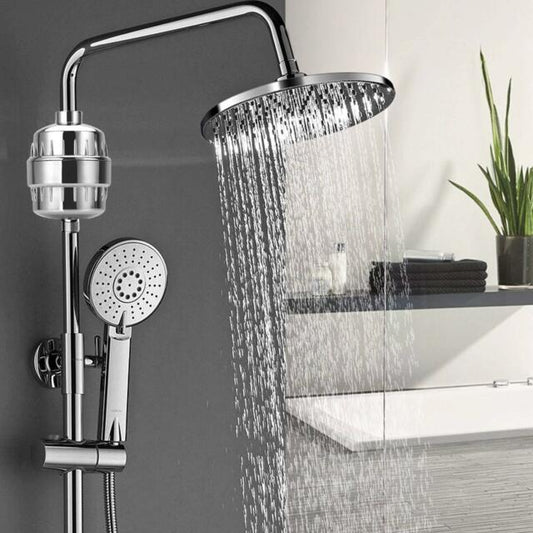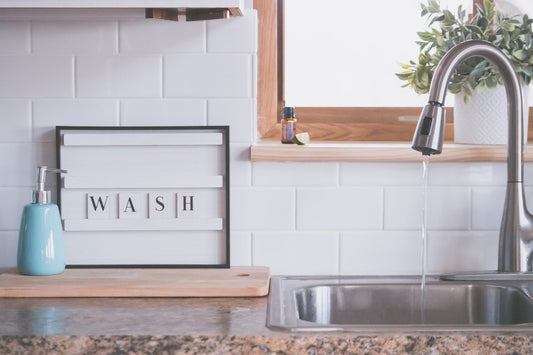What Are Chloramines?
Chloramines are a mixture of chlorine and ammonia. Water treatment facilities use them to treat municipal water so that the water contains fewer contaminants.
Technically, chloramine isn’t as effective as chlorine at killing E. coli and some other types of bacteria, so facilities use it as a secondary disinfectant — but that’s something we’ll get to later.
According to the EPA, more than one in five Americans drink chloramine-treated water. There’s a solid chance that you or someone you know lives in a city where the water is treated with chloramines. Put simply, it’s valuable information to know why.
So, what goes into chloramine water filtration? Two things: chlorine and ammonia.
Why Chlorine?
When it comes to water treatment, chlorine is one of the most popular disinfectants for getting rid of certain contaminants. It’s highly efficient at getting rid of disease-causing bacteria, viruses, and other micro-organisms (like those that cause typhoid, cholera, and dysentery, among others).
Water treatment facilities have used chlorine for over a hundred years in order to purify water and halt the spread of disease.
In 1908, Chicago and Jersey City became the first US cities to use chlorine to purify water. Since then, scientists have been using chlorine for a variety of water treatment applications: from swimming pools to water purification tablets.
Why Ammonia?
Water treatment facilities use ammonia as a secondary disinfectant (thereby forming chloramines: chlorine + ammonia). Chlorine alone is likely to react with naturally-occurring organic compounds in water, forming disinfection-by-products.
However, ammonia is less likely to react with those naturally occurring organic compounds, therefore reducing the levels of disinfection-by-products.
Are Chloramines Safe?
Chloramines have been popularly used for water treatment since the 1930s. The City of Denver began using chloramines to treat their water in 1917.
As water treatment facilities raise their standards on the acceptable levels of disinfection-by-products, chloramines are likely to become more and more popular, but that doesn’t mean there are no dangers associated with them.
Consumer Complaints Surrounding Chloramines
In San Francisco, for instance, as a result of the San Francisco Public Utility Commission adding chloramines to their water treatment system, residents formed a protest group called “Citizens Concerned About Chloramine.”
The group alleged that “many residents, unaware of the change in disinfection, suddenly began to experience adverse health effects-skin reactions (rashes, welts, blistering, dry skin, cracking, chapping, peeling, bleeding, burning sensations, scarring)…” and much more.
Furthermore, Erin Brockovich of Vermonters for a Clean Environment claims that “studies indicate chloramine causes more rapid deterioration of the municipal infrastructure and degradation of valves and fittings. In water systems that still use lead pipes or components, this causes lead and other metals to leach into drinking water and out of faucets and showerheads.”
As you can see, there have been a number of consumer complaints regarding chloramines, even though they’ve been (relatively safely) in use for more than 100 years in some municipal water treatment facilities.
Regardless, if you have any hang-ups about consuming chlorine and/or ammonia, you should look for ways to remove it from your water — particularly if you have copper pipes, because chloramines have been proven to cause leaks in certain piping.
Even if you aren’t worried about the health effects of added chloramines, according to the Water Quality Association, their removal improves the taste and odor of drinking water.
Besides, unlike the healthy minerals typically present in hard water — like magnesium and calcium — there are no health benefits associated with chloramine consumption. The best case is that they have no health effect, so why put up with drinking them every day?
So, with that said, how can you remove chloramines?
How Can You Filter Out Chloramine from Your Water Supply?
There are two primary ways in which you can remove chloramines from municipal water (as it applies to point-of-entry drinking water applications):
-
Standard activated carbon
-
Catalytic carbon
According to the Water Quality Association, since chloramines have no net charge, they’re difficult to remove through oxidation, distillation, and reverse osmosis.
On the other hand, activated carbon systems remove chloramine very effectively.
The problem with standard activated carbon, though, is that, while it’s great at removing chlorine, it’s not as good at removing chloramines. That doesn’t mean it isn’t effective at all — standard activated carbon alone is still much more effective than oxidation, distillation, and reverse osmosis when it comes to removing chloramines.
However, catalytic carbon is the industry-leading standard for chloramine removal. According to Reskem, “specialized ‘catalytic’ products are superior to standard grades [of activated carbon] offering almost twice the monochloramine removal capacity.”
Where Can You Find High-Quality Water Treatment Systems Designed to Filter Chloramines?
FilterSmart sells an FS1000 Pro with a 20-inch pre-filter, specifically designed for optimum chloramine removal.
Conclusion: Chloramine Water Filtration
Chloramine is a disinfectant compound created by the mixture of chlorine and ammonia. While it isn’t as effective for disinfectant use as chlorine alone, it doesn’t produce anywhere near the same number of disinfectant-by-products, making it an increasingly popular disinfectant.
However, chloramine use has been marked with controversy from some consumer and environmental advocacy groups, contending that the compound is ineffective, damaging local infrastructure and citizens’ health.
If you’re worried about the possible negative side effects of chloramine, look into either a standard activated carbon filter or a catalytic carbon filter. The latter is specifically designed for maximum chloramine removal, and FilterSmart’s FS1000 Pro uses the highest-quality coconut-shell activated carbon.
Questions? Concerns? Feel free to get in touch:
Call us: 866.455.9989
Email us: sales@filtersmart.com







